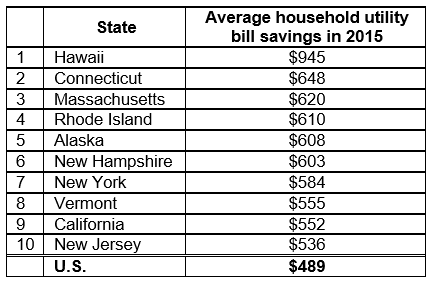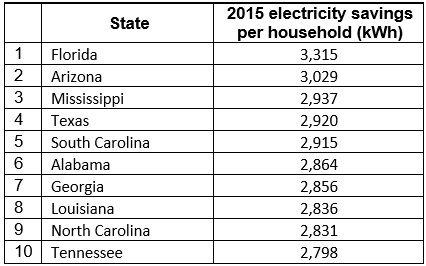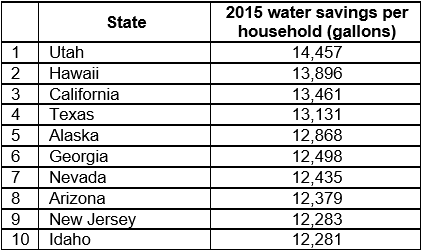ASAP/ACEEE Analysis Ranks All 50 States and DC on Electricity, Gas & Water Bill Savings; NH, NY, VT, CA, and NJ Round Out Top 10 States Where Consumers Save Most Money.
MEDIA CONTACT: Patrick Mitchell, (703) 276-3266 or pmitchell@hastingsgroup.com
WASHINGTON, DC///February 16, 2017/// The average American family saved nearly $500 on utility bills in 2015 as a direct result of existing efficiency standards for appliances and lighting, according to a new report issued today by the Appliance Standards Awareness Project (ASAP) and the American Council for an Energy-Efficient Economy (ACEEE). The report details average household savings for all 50 states and the nation’s capital in four categories: household utility bill savings; electricity savings; natural gas and oil savings; and water savings. The top 10 states for each are ranked. Consumers in Hawaii save the most on overall household utility bills — a whopping $945.
Appliance standards protect consumers and save them money by eliminating energy- and water-wasting products in the market, while preserving the performance and features consumers value and encouraging manufacturers to develop and bring to market products with improved efficiency performance.
Available online at http://www.appliance-standards.org/documents/reports/white-paper-overview, the new ASAP/ACEEE report updates previous estimates of the consumer and business benefits achieved by all existing national standards. In addition to the consumer savings, ASAP/ACEEE show big benefits for businesses too. Total business utility bill savings from standards reached nearly $23 billion in 2015. Business energy bill savings equaled 8% of total business spending on electricity and natural gas.Average household savings by state ranged from 11-27% of total consumer utility bills, with a national average savings of 16%. The top 10 states for household utility bill savings from existing appliance standards are:

Consumers in states with highest bill savings save the most, because they tend to pay the most for energy. Other factors affecting savings include the types of appliances consumers have (e.g. electric versus gas water heaters), and how much cooling and heating they use and household size. States appearing at the bottom of the overall utility bill savings list include: Washington (50), North Dakota (49), Idaho (48), Montana (47), West Virginia (46), Wyoming (45), Oregon (44), Nebraska (43), Arkansas (42) and Louisiana (41). Savings in 2015 for the bottom ten states were still significant, ranging from $360-$405.
ASAP Executive Director Andrew deLaski said: “Appliance efficiency standards are a win for Americans in every single state. There are no ‘losers’ when it comes to household savings from appliance standards.”
Commenting on the ASAP/ACEEE report, Charlie Harak, senior attorney for energy and utilities issues, National Consumer Law Center, said: "Appliance standards save low-income households money, leaving them more to buy food and pay the rent. They disproportionately are renters, not homeowners, and move into housing where the owner purchases major energy-consuming appliances like furnaces. Standards ensure that low-income renters aren't saddled with inefficient appliances that are energy hogs."
Tom Eckman, senior advisor and former Director of Power Planning, Northwest Power and Conservation Council, said: “Appliance standards have produced a virtual trifecta of benefits across the Northwest. By significantly slowing the growth in electricity demand across the Northwest, they’ve reduced the need to build expensive new power plants, kept regional power costs lower and produced significant consumer bill savings.”
ACEEE Executive Director Steven Nadel said: “Appliance standards are good for the US economy, benefitting both consumers and businesses. They generate savings that create more jobs.”
The top 10 states for per household electricity savings span the Southeast plus Texas and Arizona. These tend to be the states with the greatest air conditioner use and where electric water heating is most common. The top 10 states are as follows:

The top 10 states for per-household gas and heating oil savings are those with the largest heating needs (which is where gas and oil heating is most common) and where gas water heating is prevalent. They are as follows:

In addition to the state-by-state data on overall utility bill as well as electricity and gas/heating oil savings, the new ASAP/ACEEE report provides detailed information on water savings at the national level and for all 50 states and Washington, DC. At a national level, water savings in 2015 reached 1.5 trillion gallons, enough to meet the needs of all the households in Texas, Oklahoma, Arizona, and Colorado combined. The top 10 states for household water savings from existing appliance standards in order are:

ASAP’s deLaski added: “Appliance standards work to boost local economies by putting savings in consumers’ and business owners’ pockets. Money saved on utility bills gets plowed back into the economy, creating jobs. Energy savings in turn reduce the need to site and pay for new power generation facilities, transmission lines and pipelines, thereby helping to moderate energy prices, which further benefits all consumers and businesses. Less energy and water waste lead to less pollution, helping to protect the air and public health and easing pressure on over-burdened water supplies.”
OTHER KEY FINDINGS
- The utility bill savings from standards easily outweigh estimates of the cost to make products more efficient to meet standards. Benefits outweigh estimated costs by 5 to 1 using cost estimates made at the time standards were established.
- Accounting for products sold between 1987 and 2035 and for estimated product price increases, total net present value savings from national standards for products sold through 2035 are $2.4 trillion for US consumers and businesses, or roughly enough to purchase 70 million new cars based on 2016 average prices.
ABOUT THE GROUPS
ASAP (www.appliance-standards.org) organizes and leads a broad-based coalition effort that works to advance, win and defend new appliance, equipment and lighting standards which deliver large energy and water savings, monetary savings and environmental benefits. Working together, the ASAP coalition supports new and updated standards at the national and state levels through technical and policy advocacy and through outreach and education. ASAP was founded in 1999 by the American Council for an Energy-Efficient Economy, the Alliance to Save Energy, the Energy Foundation, and Natural Resources Defense Council.
The American Council for an Energy-Efficient Economy acts as a catalyst to advance energy efficiency policies, programs, technologies, investments, and behaviors. For information about ACEEE and its programs, publications, and conferences, visit aceee.org
Since 1969, the nonprofit National Consumer Law Center® [www.nclc.org] has used its expertise in consumer law and energy policy to work for economic security for low-income and other disadvantaged people in the United States. NCLC has a strong focus on ensuring that low-income households can afford the energy they need. Advocating for strong appliance standards are a key part of that effort.
The Northwest Power and Conservation Council is an interstate agency that was formed in 1981 by the states of Idaho, Montana, Oregon and Washington under Congressional authorization granted by the Northwest Electric Power Planning and Conservation Act of 1980 (Power Act). This federal statute charged the Council with developing a regional power and conservation plan to assure the Pacific Northwest of an adequate, efficient, economical, and reliable power supply and to protect, mitigate and enhance the fish and wildlife resources impacted by the development and operation of the federal hydroelectric generating projects on the Columbia and Snake Rivers.




